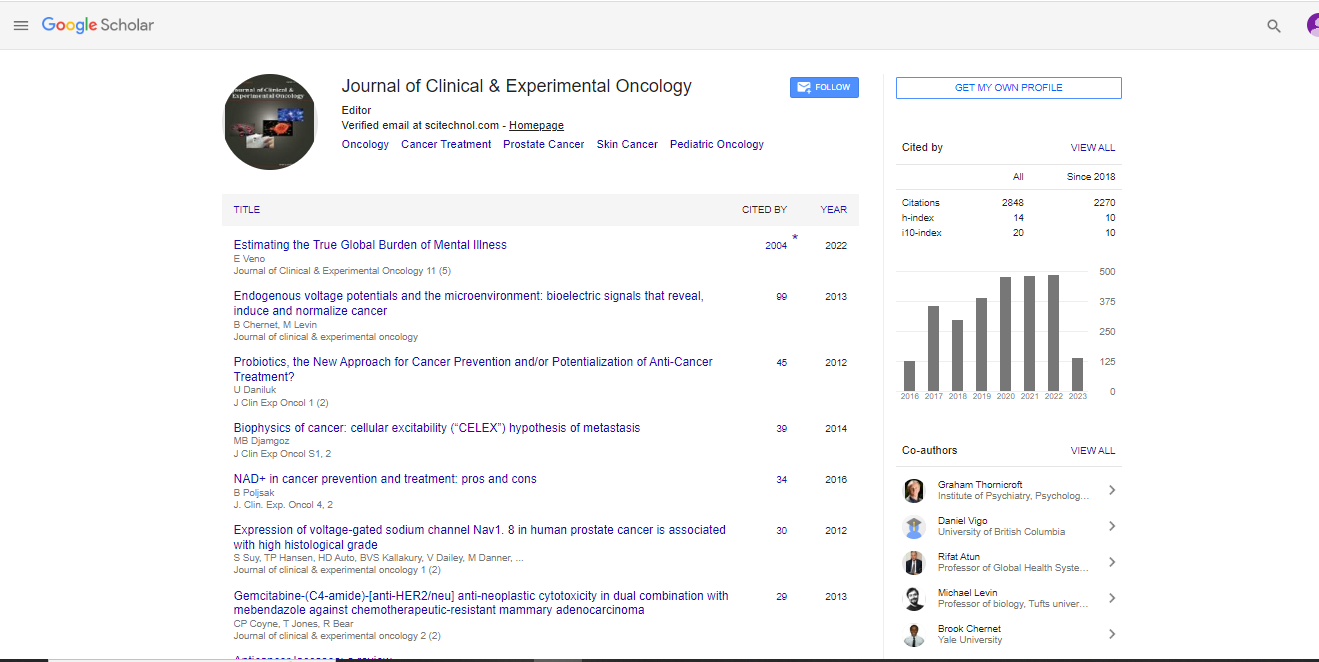Review Article, J Clin Exp Oncol Vol: 3 Issue: 3
A diagnostic biomarker: differential expression of LMP2/β1i in human uterine neoplasms
| Takuma Hayashi1,11*, Akiko Horiuchi2, Kenji Sano3, Nobuyoshi Hiraoka4, Tomoyuki Ichimura5, Osamu Ishiko5, Yae Kanai4,12, Nobuo Yaegashi6, Tanri Shiozawa7, Hiroyuki Aburatani8, Susumu Tonegawa9 and Ikuo Konishi10 |
| 1Department of Immunology and Infectious Disease, School of Medicine, Shinshu University, Matsumoto, Nagano, Japan. |
| 2Horiuchi Ladies Clinic, Matsumoto, Nagano, Japan |
| 3Department of Laboratory Medicine, Shinshu University Hospital, Japan |
| 4Division of Pathology, National Cancer Center Research Institute, Japan |
| 5Department of Obstetrics and Gynecology, Graduate School of Medicine, Osaka City University, Japan |
| 6Department of Obstetrics and Gynecology, Graduate School of Medicine, Tohoku University, Japan |
| 7Department of Obstetrics and Gynecology, School of Medicine, Shinshu University, Japan |
| 8The Cancer System Laboratory, Research Center for Advanced Science and Technology, the University of Tokyo, Japan |
| 9Picower Institute and Department of Biology, Massachusetts Institute of Technology, U.S.A |
| 10Dept. of Obstetrics and Gynecology, Kyoto University Graduate School of Medicine, Japan |
| 11Promoting Business using Advanced Technology, Japan Science and Technology Agency (JST) |
| 12The International Human Epigenome Consortium (IHEC) and CREST, Japan Science and Technology Agency (JST) |
| Corresponding author : Takuma Hayashi Department of Immunology and Infectious Disease, Graduate School of Medicine, Shinshu University, 3-1-1, Asahi, Matsumoto, Nagano 390-8621, Japan. Tel: 81-263-37-2611; Fax: 81-263-37-2613 E-mail: yoyoyo224@hotmail.com |
| Received: February 20, 2014 Accepted: August 11, 2014 Published: August 14, 2014 |
| Citation: Hayashi T, Horiuchi A, Sano K, Hiraoka N, Ichimura T, et al. (2014) A Diagnostic Biomarker: Differential Expression of LMP2/ß1i in Human Uterine Neoplasms. J Clin Exp Oncol 3:3. doi:10.4172/2324-9110.1000128 |
Abstract
Uterine leiomyosarcoma (Ut-LMS) more frequently develops in the muscle tissue layer of the uterine body than in the uterine cervix. The development of gynecological tumors is often correlated with the secretion of female hormones; however, the development of Ut-LMS has not been correlated with hormonal conditions, and risk factors remain unknown. A diagnostic biomarker that can distinguish malignant Ut-LMS from benign tumor leiomyoma (LMA) has not yet been established. Therefore, an analysis of the risk factors associated with human Ut-LMS is needed in order to establish a treatment method. Proteasome LMP2/β1i-deficient mice spontaneously develop Ut-LMS, with a disease prevalence of ~40% by 14 months of age. We found that the expression of LMP2/β1i was absent in human Ut-LMS, but present in human LMA. Therefore, the defective expression of LMP2/β1i may be one of the risk factors for Ut-LMS. LMP2/β1i is may be a potential diagnostic biomarker for human Ut-LMS, and may be a targeted molecule for a new therapeutic approach.
Keywords: LMP2; Uterine leiomyosarcoma; Leiomyoma; Biomarker
Keywords |
|
| LMP2; Uterine leiomyosarcoma; Leiomyoma; Biomarker. | |
Review |
|
| The uterus is composed of three layers: the uterine endometrium, which serves as a bed for the embryo, the myometrium of the wall, which protects the embryo, and a serous membrane that envelopes the uterus. The term “uterine tumor” generally refers to an epithelial malignant tumor of the uterus, which is roughly classified as a tumor of the uterine cervix or uterine body. Because of the prevalence of medical checkups, the rate of mortality from uterine cervix malignant tumors is decreasing, and is typically detected at a very early stage. In contrast, the mortality rate for malignant tumors of the uterine body is increasing, and is rarely detected at the initial stages. While most tumors of the uterine body are adenocarcinomas, uterine cervix tumors are classified into squamous cancer and adenocarcinoma. Uterine mesenchymal tumors, which develop in the myometrium, have traditionally been divided into benign LMA and malignant Ut- LMS based on cytological atypia, mitotic activity, and other criteria. Ut-LMS is relatively rare, having an estimated annual incidence of 0.64 per 100,000 women [1]. Ut-LMS accounts for 2% to 5% of tumors of the uterine body and develops more often in the muscle layer of the uterine body than in the uterine cervix. As Ut-LMS is resistant to chemotherapy and radiotherapy, surgical intervention is virtually the only means of treatment [2,3]. The prognosis for Ut-LMS is not good, with the five-year survival rate being approximately 35%. However, the development of an efficient adjuvant therapy is expected to improve this rate. Uterine LMA may occur in as many as 70% ~ 80% of women by the age of 50 years [4]. However, difficulties have been associated with distinguishing uterine LMA from Ut-LMS, and a diagnosis generally involves surgery and cytoscopy. Diagnostic categories for uterine mesenchymal tumors and morphological criteria are used to assign cases. The non-standard subtypes of uterine mesenchymal tumors, such as the epithelioid and myxoid types, are classified in a different way using these features; therefore the establishment of a diagnostic method to identify non-standard smooth muscle differentiation is important [5,6]. | |
| High estrogen levels are considered to have a significantly impact on the development of tumors in the uterine body [7]. Although the mechanisms by which uterine LMA and Ut-LMS develop remain unknown tumors that have developed in the myometrium gradually become larger due to the influence of the female hormone, estrogen, and generate tumors. However, no correlation has been reported between the development of Ut-LMS and hormonal conditions, and no obvious risk factors have been identified. Although cases that are accompanied by hypocalcaemia or eosinophilia have been reported, neither clinical abnormality is an initial risk factor for Ut-LMS. The identification of a risk factor associated with the development of Ut- LMS may significantly contribute to the development of preventive and therapeutic treatments. | |
| Cytoplasmic proteins are mostly degraded by a protease complex, which has many substrates consisting of twenty-eight 20 to 30-kDa subunits, referred to as the 20S proteasome [8,9]. Proteasomal degradation is essential for many cellular processes, including the cell cycle, the regulation of gene expression, and immunological function [10]. Interferon(IFN)- β induces the expression of large numbers of responsive genes, proteasome β-ring subunits, i.e., low-molecular mass polypeptide (LMP)2/β1i, LMP7/β5i, and LMP10/β2i [11]. A molecular approach to studying the correlation between IFN-g and tumor cell growth has been attracting increasing attention. | |
| Homozygous mice deficient in LMP2/β1i show tissue- and substrate-dependent abnormalities in the biological functions of the proteasome [12]. Ut-LMS reportedly occurred in female LMP2/β1i−/− mice aged 6 months or older, and its incidence at 14 months of age was approximately 40% [13]. Histological studies of LMP2/β1i-lacking uterine tumors have revealed characteristic abnormalities in Ut-LMS [13]. These tumors consiste of uniformly elongated myometrium cells arranged in bundles. The nuclei of the tumor cells varied in size and shape, and mitosis was frequently observed. In contrast, the myometrium cells of LMP2/β1i+/+ mice were normal in appearance. Whereas relatively few ki-67-positive cells, the proliferating cells of tumors, were observed in the basal cell layer of the normal myometrium, most of the basal cells in LMP2/β1i−/− mice strongly expressed ki-67 [13]. LMP2/β1i−/− mice that have developed Ut-LMS undergo considerable weight loss, and die by 14 months of age. LMP2/ β1i−/− mice also exhibit skeletal muscle metastasis from Ut-LMS. Therefore, it is likely that LMP2/β1i−/− mice with Ut-LMS die as a result of the tumor mass and metastasis. | |
| The non-standard subtypes of uterine mesenchymal tumors such as the epithelioid and myxoid types are classified in a different way using these features; therefore the establishment of a diagnostic method for the identification of non-standard smooth muscle differentiation is required [5,6]. Pathological studies were performed to demonstrate the validity and reliability of LMP2/β1i as a diagnostic biomarker when combined with other candidate molecules, for example cyclin E and calponin h1, which reportedly function as anti-tumorigenic factors in human Ut-LMS. Pathological studies revealed a strongler loss in the ability to induce the expression of LMP2/β1i and calponin h1 in human Ut-LMS tissues than in uterine LMA or normal myometrium located in the same section, and the marked expression of cyclin E in human Ut-LMS tissues only [14-17]. Histological findings were consistent with metastatic LMS for skeletal muscle and rectum lesions [14,15]. In western blotting and RT-PCR experiments, LMP2/β1i was expressed in the normal myometrium, but not in human Ut-LMS, both of which were strongly supportive of the pathological findings [14,15,17]. Although we previously demonstrated that the abnormal expression of the ovarian steroid receptors, TP53 and ki-67, and mutations in TP53 were frequently associated with human Ut-LMS, the defective expression of LMP2/β1i appeared to be more characteristic of Ut-LMS than these factors [15,16]. | |
| In the case of gynecological cancers, a female hormonal imbalance is often a risk factor for developing tumors [7]. However as in the case of uterine LMA, a correlation has not yet been reported between the development of Ut-LMS, the female hormone, and hormone receptors. A recent study showed the expression of Lmp2/β1i mRNA and protein in luminal and glandular epithelia, placenta villi, trophoblastic shells, and arterial endothelial cells [18-20]. These findings implicated LMP2/ β1i in the invasion of placental villi, degradation of the extracellular matrix, immune tolerance, glandular secretion, and angiogenesis. The differential responsiveness of the SKN human uterine LMS cell line to the genetically-modified stable expression of LMP2/β1i was investigated to determine whether a LMP2/β1i deficiency was crucial for the development of uterine LMS. SKN cells (approximately 5 x l05 cells) were transfected with 5 βg of control vector DNA (pCEM9), pCEM9-LMP2/β1iwt, or pCEMp-LMP2/β1iK33A, which had no effect on the immunoproteasome function due to its non-incorporation into the 20S proteasome. Several studies suggested that the suppression of cell proliferation, tumorigenesis, and morphological changes in uterine LMS cells observed under the stable expression of LMP2/β1i may only be due to the biological function of the single-molecule LMP2/β1i, without the involvement of its immunoproteasome function [14,15,17]. Vascular endothelial growth factor (VEGF) family is a glycosylated mitogen that specifically acts on endothelial cells and exerts various effects, including mediating an increased in vascular permeability, inducing angiogenesis, vasculogenesis and endothelial cell growth, promoting cell migration, and inhibiting apoptosis. Therefore, the VEGF family and its receptors are involved in carcinogenesis, invasion, and tumor angiogenesis. Further experiments clarified the inhibiting effects of the single-molecule LMP2/β1i on the expression of the VEGF family; however, the underlying mechanism by which LMP2/β1i promotes tumor metastasis remain poorly understood. Further experiments are also required to elucidate the molecular mechanism of human Ut-LMS tumorigenesis and tumor angiogenesis involved in the biological significance of LMP2/β1i [15,17,21]. | |
| The individual expression of LMP2/β1i, LMP7/β5i and LMP10 (MECL-1)/ β2i subunits is believed to contribute to the initiation and development of disorders. Variations in the expression of proteasome β-subunits in the serum can be used as a diagnostic biomarker. A recent study revealed a unique role for LMP7/β2i in controlling pathogenic immune responses and provided a therapeutic rationale for targeting LMP7/β2i in autoimmune disorders, especially rheumatoid arthritis [22]. The selective inhibition of LMP7/β2i blocked the production of interleukin-23 (IL-23) due to the activation of monocytes, and interferon-γ and IL-2 by T cells. In mouse models of rheumatoid arthritis, a LMP7/β2i-inhibitory treatment was shown to reverse the signs of this disease and resulted in reductions in cellular infiltration, cytokine production, and autoantibody levels. Recent studies have demonstrated that LMP2/β1i is obligatory for tumor surveillance and also has a tissue-specific role in protection against spontaneous uterus neoplasms [14,15,17]. Unfortunately serum LMP2/β1i levels in patients with uterine mesenchymal tumors, specifically leiomyosarcoma have not yet been examined in detail. | |
| To determine whether LMP2/β1i is a biomarker that can be used to distinguish human Ut-LMS from uterine LMA when combined with other candidate molecules, especially cyclin E and calponin h1, which have been identified as potential diagnostic candidates [17,23-25], we investigated the reliability and characteristics of LMP2/β1i as a diagnostic indicator at several clinical research facilities [23]. This clinical research has not yet been concluded, and large-scale clinical studies are needed at additional clinical research facilities. The histologic and IHC characteristics of uterine mesenchymal tumors including mitotically active leiomyoma, bizarre leiomyoma, lipoleiomyoma, uterine smooth muscle tumors of uncertain malignant potential (STUMP), and leiomyomatoid angiomatous neuroendocrine tumor (LANT) are summarized [26,27]. Clarification of the correlation between these factors and the development of human Ut- LMS as well as the identification of specific risk factors may lead to the development of new clinical treatments for this disease. | |
Acknowledgements |
|
| This study was supported in part by grants from the Ministry of Education, Culture, Science and Technology, and The Foundation of Osaka Cancer Research, The Foundation for the Promotion of Cancer Research, The Kanzawa Medical Research Foundation and The Takeda Foundation for Medical Science. | |
| This project was supported by Promoting Business using Advanced Technology, Japan Science and Technology Agency (JST) and under the research cooperation of Professor Susumu Tonegawa (Picower Institution and Dept. of Biology, Massachusetts Institute of Technology). | |
References |
|
|
 Spanish
Spanish  Chinese
Chinese  Russian
Russian  German
German  French
French  Japanese
Japanese  Portuguese
Portuguese  Hindi
Hindi 



